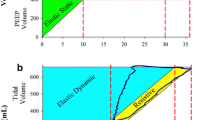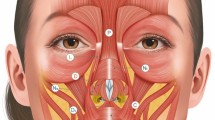Abstract
Cold air-induced rhinitis is a common complaint of individuals with chronic allergic or nonallergic rhinitis and those with no chronic nasal disease. It is characterized by rhinorrhea, nasal congestion, and nasal burning that appear within minutes of exposure to cold air and dissipate soon after exposure is terminated. The symptoms of cold-air rhinitis are reproduced experimentally with nasal cold-air provocation. This procedure has shown that nasal mast cell activation and sensory nerve stimulation are associated with the development of nasal symptoms. Sensory nerve activation generates a cholinergic reflex that leads to rhinorrhea; therefore, anticholinergic agents are highly effective in treating cold-air rhinitis. Experimental data suggest that individuals with nasal cold-air sensitivity may have reduced ability to compensate for the water loss that occurs during exposure to cold air. Therefore, the symptoms of cold air-induced rhinitis may reflect the activation of compensatory mechanisms to restore mucosal homeostasis.
Similar content being viewed by others
References and Recommended Reading
Baroody F, Canning B: Comparative anatomy of the nasal and tracheal/broncheal airways. In Upper and Lower Respiratory Disease. Edited by Lenfant C, Corren J, Togias A, Bousquet J. New York: Marcel Dekker; 2003:1–51.
Anderson S, Togias A: Dry air and hyperosmolar challenge in asthma and rhinitis. In Asthma and Rhinitis. Edited by Busse WW, Holgate S. Malden, MA: Blackwell Scientific Publications; 2000:1449–1468.
Hanes L, Issa E, Proud D, et al.: Stronger nasal responsiveness to cold air in individuals with rhinitis and asthma, compared with rhinitis alone. Clin Exp Allergy 2005, 36:26–31.
Silvers WS: The skier’s nose: a model of cold-induced rhinorrhea. Ann Allergy 1991, 67:32–36.
Kauffman F, Neukirch F, Annesi I, et al.: Relation of perceived nasal and bronchial hyperresponsiveness to FEV1, basophil counts, and methacholine response. Thorax 1988, 43:456–461.
Diemer F, Sanico A, Horowitz E, et al.: Non-allergenic inhalant triggers in seasonal and perennial allergic rhinitis [abstract]. J Allergy Clin Immunol 1999, 103:S2.
Rouadi P, Barooody F, Abbott D, et al.: A technique to measure the ability of the human nose to warm and humidify air. J Appl Physiol 1999, 87:400–406.
Keck T, Leiacker R, Heinrich A, et al.: Humidity and temperature profile in the nasal cavity. Rhinology 2000, 38:167–171.
Cauna N: Fine structure of the arteriovenous anastomosis and its nerve supply in the human nasal respiratory mucosa. Anat Rec 1970, 168:9–22.
Cauna N, Cauna D: The fine structure and innervation of the cushion veins of the human nasal respiratory mucosa. Anat Rec 1975, 181:1–16.
Pinto JM, Assanasen P, Baroody FM, et al.: Alpha-adreno-receptor blockade with phenoxybenzamine does not affect the ability of the nose to condition air. J Appl Physiol 2005, 99:128–133.
Cole P: Respiratory mucosal vascular responses, air conditioning and thermo regulation. J Laryngol Otol 1954, 68:613–622.
Tos M: Goblet cells and glands in the nose and paranasal sinuses. In The Nose: Upper Airway Physiology and the Atmospheric Environment. Edited by Proctor DF, Andersen IB. Amsterdam: Elsevier Biomedical Press; 1982:99–144.
Ingelstedt S, Ivstam B: Study in the humidifying capacity of the nose. Acta Otolaryngol 1951, 39:286–290.
Assanasen P, Baroody F, Rouadi P, et al.: Ipratropium bromide increases the ability of the nose to warm and humidify air. Am J Respir Crit Care Med 2000, 162:1031–1037.
Yankaskas J, Gatzy J, Boucher R: Effects of raised osmolarity on canine tracheal epithelial ion transport function. J Appl Physiol 1987, 62:2241–2245.
Knowles M, Clark C, Fischer N, et al.: Nasal secretions: role of epithelial ion transport. In Allergic and Vasomotor rhinitis: pathophysiological aspects. Edited by Mygind N, Pipkorn U. Copenhagen: Munksgaard; 1983:77–90.
Welsh M: Electrolyte transport by airway epithelia. Physiol Rev 1987, 67:1143–1184.
Boucher R, Chang E, Paradiso A, et al.: Chloride secretory response of cystic fibrosis human airway epithelia. J Clin Invest 1989, 84:1424–1431.
Cruz A, Naclerio R, Lichtenstein L, et al.: Further support for the role of hypertonicity on mast cell activation during nasal dry air reactions [abstract]. Clin Research 1990, 38:484A.
Assanasen P, Baroody F, Abbott D, et al.: Natural and induced allergic responses increase the ability of the nose to warm and humidify air. J Allergy Clin Immunol 2000, 106:1045–1052.
Rozsasi A, Leicker R, Keck T: Nasal conditioning in perennial allergic rhinitis after nasal allergen challenge. Clin Exp Allergy 2004, 34:1099–1104.
Pinto J, Assanasen P, Baroody F, et al.: Treatment of nasal inflammation decreases the ability of subjects with asthma to condition inspired air. Am J Respir Crit Care Med 2004, 170:863–869.
Togias A, Naclerio R, Proud D, et al.: Nasal challenge with cold, dry air results in the production of inflammatory mediators: Possible mast cell involvement. J Clin Invest 1985, 76:1375–1381.
Proud D, Bailey G, Naclerio R, et al.: Typtase and histamine as markers to evaluate mast cell activation during the responses to nasal challenge with allergen, cold, dry air, and hyperosmolar solutions. J Allergy Clin Immunol 1992, 89:1098–1110.
Philip G, Jankowski R, Baroody F, et al.: Reflex activation of nasal secretion by unilateral inhalation of cold dry air. Am Rev Respir Dis 1993, 148:1616–1622.
Cruz A, Togias A, Lichtenstein L, et al.: Local application of atropine attenuates the upper airway reaction to cold, dry air. Am Rev Resp Dis 1992, 146:340–346.
Togias A, Proud D, Kagey-Sobotka A, et al.: The effect of a topical tricyclic antihistamine on the response of the nasal mucosa to challenge with cold, dry air and histamine. J Allergy Clin Immunol 1987, 79:599–604.
Cruz A, Togias A, Lichtenstein L, et al.: Steroid-induced reduction of histamine release does not alter the clinical nasal response to cold, dry air. Am Rev Respir Dis 1991, 143:761–765.
van Rijswijk J, Boeke E, Keizer J, et al.: Intransal capsaicin reduces nasal hyperreactivity in idiopathic rhinitis: a double-blind randomized application regimen study. Allergy 2003, 58:754–761.
Smith C, Anderson S: Hyperosmolarity as the stimulus to asthma induced by hyperventilation? J Allergy Clin Immunol 1986, 77:729–736.
McFadden E: Hypothesis: exercise-induced asthma as a vascular phenomenon. Lancet 1990, 1:880–882.
Lawrence I, Warner J, Cohan V, et al.: Purification and characterization of human skin mast cells: evidence for human mast cell heterogeneity. J Immunol 1987, 139:3062–3069.
McKemy DD, Neuhausser WM, Julius D: Identification of a cold receptor reveals a general role for TRP channels in thermosensation. Nature 2002, 416:52–58.
Peier AM, Moqrich A, Hergarden AC, et al.: A TRP channel that senses cold stimuli and menthol. Cell 2002, 108:705–715.
Story GM, Peier AM, Reeve AJ, et al.: ANKTM1, a TRP-like channel expressed in nociceptive neurons, is activated by cold temperatures. Cell 2003, 112:819–829.
Reid G: ThermoTRP channels and cold sensing: what are they really up to? Pflugers Arch 2005, 451:250–263.
Kobayashi K, Fukuoka T, Obata K, et al.: Distinct expression of TRPM8, TRPA1, and TRPV1 mRNAs in rat primary afferent neurons with a-delta/c-fibers and colocalization with trk receptors. J Comp Neurol 2005, 493:596–606.
Togias A, Proud D, Kagey-Sobotka A, et al.: The osmolality of nasal secretions increases when inflammatory mediators are released in response to inhalation of cold, dry air. Am Rev Respir Dis 1988, 137:625–629.
Eggleston P, Kagey-Sobotka A, Schleimer R, Lichtenstein LM: Interaction between hyperosmolar and IgE-mediated histamine release from basophils and mast cells. Am Rev Respir Dis 1984, 130:86–91.
Silber G, Proud D, Warner J, et al.: In vivo release of inflammatory mediators by hypersomolar solutions. Am Rev Respir Dis 1988, 137:606–612.
Togias A, Lykens K, Kagey-Sobotka A, et al.: Studies on the relationships between sensitivity to cold dry air, hyperosmolar solutions and histamine in the adult nose. Am Rev Respir Dis 1990, 141:1428–1433.
Sanico AM, Philip G, Lai G, et al.: Hyperosmolar saline induces reflex nasal secretions, evincing neural hyper-responsiveness in allergic rhinitis. J Appl Physiol 1999, 86:1202–1210.
Ahern GP, Brooks IM, Miyares RL, et al.: Extracellular cations sensitize and gate capsaicin receptor TRPV1 modulating pain signaling. J Neurosci 2005, 25:5109–5116.
Caterina M, Schumachert M, Tominaga M, et al.: The capsaicin receptor: a heat-activated ion channel in the pain pathway. Nature 1997, 389:816–824.
Baraniuk J, Ali M, Yuta A, et al.: Hypertonic saline nasal provocation stimulates nociceptive nerves, substance P release, and glandular mucous exocytosis in normal humans. Am J Respir Crit Care Med 1999, 160:655–662.
Braat J, Mulder P, Fokkens W, et al.: Intranasal cold dry air is superior to histamine challenge in determining the presence and degree of nasal hyperreactivity in nonallergic noninfectious perennial rhinitis. Am J Respir Crit Care Med 1998, 157:1748–1755.
Taylor-Clark T, Kollarik M, MacGlashan D, et al.: Nasal sensory nerve populations responding to histamine and capsaicin. J Allergy Clin Immunol 2005, 116:1282–1288.
Sanico AM, Koliatsos VE, Stanisz AM, et al.: Neural hyperresponsiveness and nerve growth factor in allergic rhinitis. Int Arch Allergy Immunol 1999, 118:153–158.
Cruz AA, Naclerio RM, Proud D, et al.: Epithelial shedding is associated with nasal reactions to cold, dry air. J Allergy Clin Immunol 2006, 117:1351–1358.
Sahin-Yilmaz A, Pinto JM, de Tineo M, et al.: Familial aggregation of nasal conditioning capacity. J Appl Physiol 2007, 103:1078–1081.
Assanasen P, Baroody F, Naureckas E, et al.: The nasal passage of subjects with asthma has a decreased ability to warm and humidify inspired air. Am J Resp Crit Care Med 2001, 164:1640–1646.
Heir T: Longitudinal variations in bronchial responsiveness in cross-country skiers and control subjects. Scand J Med Sci Sports 1994, 4:134–139.
Bonini S, Bonini M, Bousquet J, et al.: Rhinitis and asthma in athletes: an ARIA document in collaboration with GA2LEN. Allergy 2006, 61:681–692.
Author information
Authors and Affiliations
Corresponding author
Rights and permissions
About this article
Cite this article
Cruz, A.A., Togias, A. Upper airways reactions to cold air. Curr Allergy Asthma Rep 8, 111–117 (2008). https://doi.org/10.1007/s11882-008-0020-z
Published:
Issue Date:
DOI: https://doi.org/10.1007/s11882-008-0020-z




